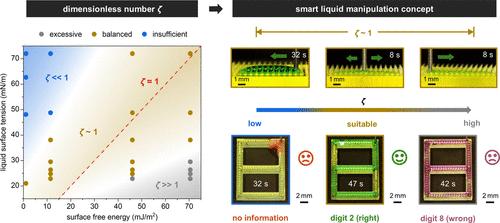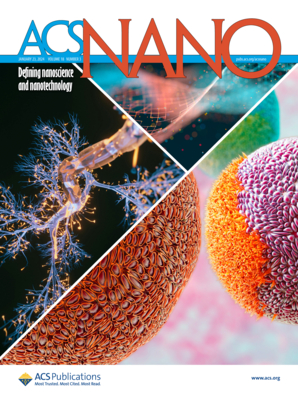Smart Directional Liquid Manipulation on Curvature-Ratchet Surfaces
IF 15.8
1区 材料科学
Q1 CHEMISTRY, MULTIDISCIPLINARY
引用次数: 0
Abstract
Structured surfaces leverage interfacial energy for directional liquid manipulation without external power, showing tremendous potential in microfluidics, green energy and biomedical applications. While the interplay of interfacial energy between solid surfaces and liquids is crucial for liquid manipulation, a systematic understanding of how the balance in liquid–solid interfacial energy affects liquid behaviors remains lacking. Here, using the curvature-ratchet surface as a generic example, we reveal the complex directional liquid dynamics inherent in the subtle regulation of liquid–solid interfacial energy. We show that curvature and tilt features regulate Laplace pressure asymmetry to enable directional, bidirectional and reverse liquid manipulation. These processes can be modulated by surface free energy and liquid surface tension, and we define their ratio as a new dimensionless number ζ to characterize the liquid–solid interfacial energy relationship. The balanced liquid control happens when ζ ∼ 1, which facilitates versatile liquid behaviors, e.g., fan-shaped spreading, gradient-induced redirection, and back-and-forth transport on various surface array arrangements, all resulting from matching structural designs with the proper ζ. Inspired by this, we showcase an innovative liquid-based information encryption technique, where the liquid displays correct information on preprogrammed surfaces only at designated ζ values. This study lays the groundwork for smart directional liquid manipulation and broadens its application domains.

求助全文
约1分钟内获得全文
求助全文
来源期刊

ACS Nano
工程技术-材料科学:综合
CiteScore
26.00
自引率
4.10%
发文量
1627
审稿时长
1.7 months
期刊介绍:
ACS Nano, published monthly, serves as an international forum for comprehensive articles on nanoscience and nanotechnology research at the intersections of chemistry, biology, materials science, physics, and engineering. The journal fosters communication among scientists in these communities, facilitating collaboration, new research opportunities, and advancements through discoveries. ACS Nano covers synthesis, assembly, characterization, theory, and simulation of nanostructures, nanobiotechnology, nanofabrication, methods and tools for nanoscience and nanotechnology, and self- and directed-assembly. Alongside original research articles, it offers thorough reviews, perspectives on cutting-edge research, and discussions envisioning the future of nanoscience and nanotechnology.
文献相关原料
公司名称
产品信息
阿拉丁
Potassium hydroxide
阿拉丁
Isopropyl alcohol
阿拉丁
Ethanol
 求助内容:
求助内容: 应助结果提醒方式:
应助结果提醒方式:


